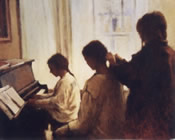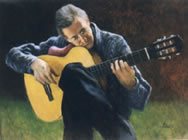|
Olaf Palm describes how he acquired his anachronistic love for 17th century painting during an era when Abstract Expressionism was all the rage:
 "In an art history class I saw slides of the Dutch Masters of the 17th century and other European paintings of the period. What got to me was Rembrandt, Hals, Vermeer and the paintings of the Utrecht School-- what they call the 'Little Masters.' That was my first eye opener. Something in me just opened up when I saw those pictures..." "In an art history class I saw slides of the Dutch Masters of the 17th century and other European paintings of the period. What got to me was Rembrandt, Hals, Vermeer and the paintings of the Utrecht School-- what they call the 'Little Masters.' That was my first eye opener. Something in me just opened up when I saw those pictures..."
In 1963 Palm was able to go to Holland and directly experience the art and culture that had so changed his life in college. He says that the trip crystallized his love of both travel and a type of painting.
Then came over ten years of work, experiment, study:
"I spent a lot of time looking at paintings, meeting people, and mostly just working, working, working -- finding out how to paint that old-timey way. I began to feel a great need to work in Europe again and luckily the opportunity came....
"Through all five of those subsequent trips to Europe I was trying to work it out, to get closer to what I wanted to do.
"I've come to rely more and more on my hands. After twenty five years I'm beginning to think I know how it's supposed to look. The moves are becoming automatic. They're getting good. It's as if my hands have brains of their own, and once I get an idea in my head I can let the hands go."
"I like to paint people. People involved in something that's important to them. The human experience has been the constant in my work. A focal point is people and tools. The most fascinating tools to me are the simplest ones, or those that are improved versions of basic tools. For instance, a hammer is an improved stick. A small boat is an improved log. I think all musical instruments are tools -- tools of amusement, and perhaps, of the spirit. Even a book or magazine is a tool of knowledge.
"Each of my pictures starts like a formal combat -- tentative positioning, quick thrusts, establishing a place or two to go from. Then, ideally, comes the strength and depth; the whole picture starts to emerge. If my errors are not too serious or too many, I gain strength and begin to love the contest. In the end the picture and I are together, needing each other."
"I believe that an artist has a responsibility to his or her society. This responsibility is conceptual, not practical. The form it takes is not the point. The artist's intention to contribute may not be deliberate. But it is felt by the very fact that what the artist is doing is both a reflection of, and a commentary on, his location in history."
--excerpts from "Olaf Palm Commentaries," by Antonia Lamb. Southwest Art, August 1982
|
 "In an art history class I saw slides of the Dutch Masters of the 17th century and other European paintings of the period. What got to me was Rembrandt, Hals, Vermeer and the paintings of the Utrecht School-- what they call the 'Little Masters.' That was my first eye opener. Something in me just opened up when I saw those pictures..."
"In an art history class I saw slides of the Dutch Masters of the 17th century and other European paintings of the period. What got to me was Rembrandt, Hals, Vermeer and the paintings of the Utrecht School-- what they call the 'Little Masters.' That was my first eye opener. Something in me just opened up when I saw those pictures..."
